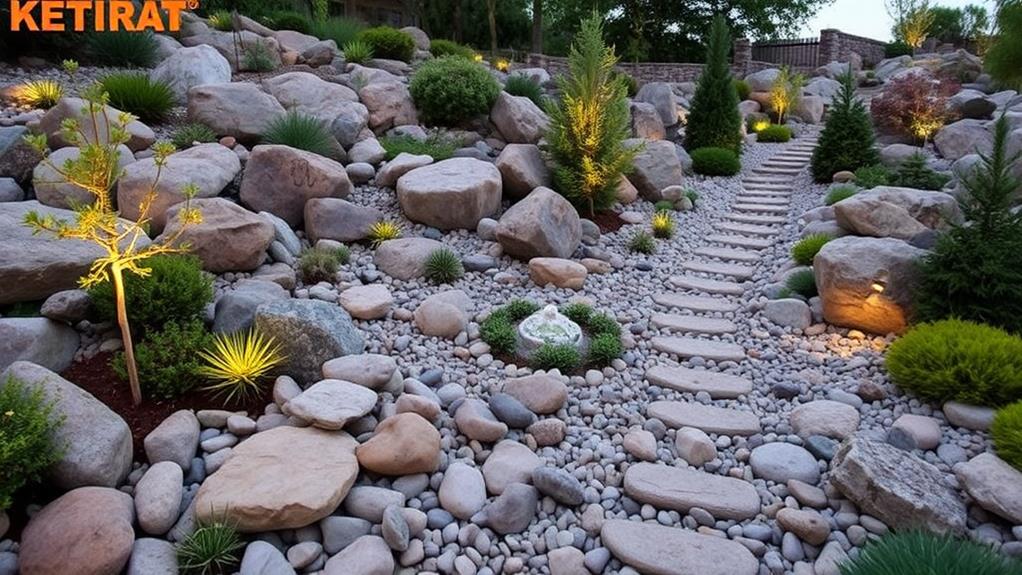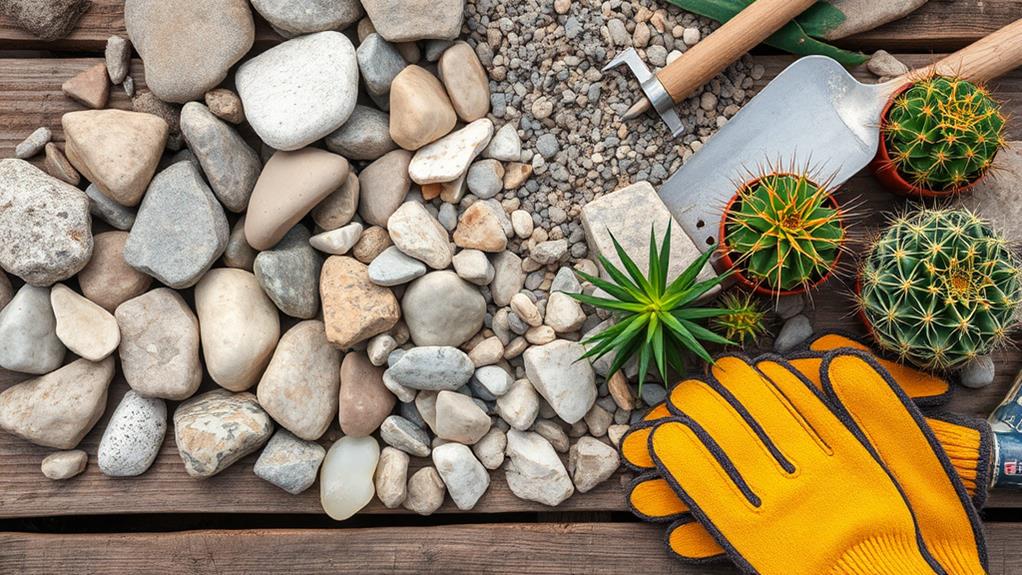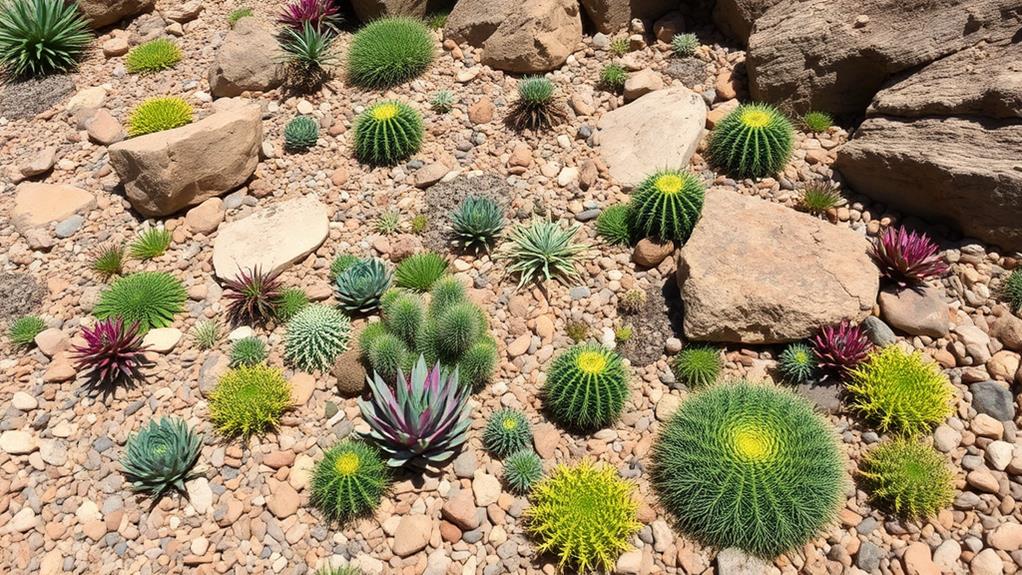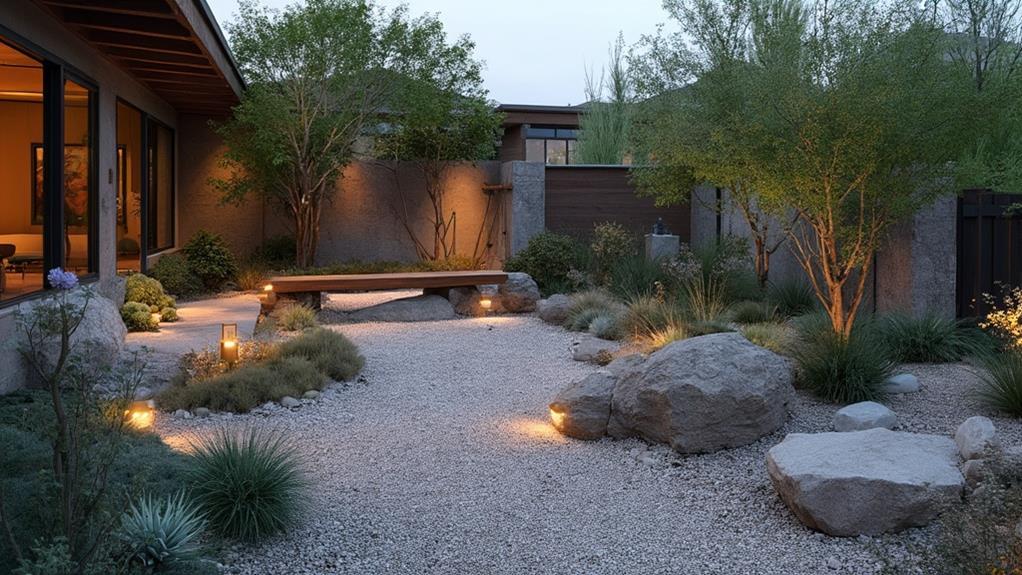Rock gardens offer a stunning, low-maintenance solution for outdoor living renovations. These landscapes combine natural stones, gravel, and drought-resistant plants to create visually appealing arrangements that thrive with minimal intervention. Ideal for areas with poor soil or challenging terrain, rock gardens are water-efficient and require little upkeep. When designing a rock garden, consider sunlight exposure, drainage, and integration with existing features. Choose a variety of rock sizes and shapes, incorporate organic curves, and select drought-tolerant plants for year-round interest. With proper planning and plant selection, a rock garden can transform your outdoor space into a serene, sustainable oasis.
Benefits of Rock Gardens

With minimal upkeep required, rock gardens offer a compelling solution for homeowners seeking low-maintenance outdoor spaces. These versatile landscapes combine natural stones, gravel, and drought-resistant plants to create visually striking arrangements that thrive with little intervention. Rock gardens are particularly well-suited for areas with poor soil quality or challenging terrain, as they can transform previously unusable spaces into attractive focal points.
One of the primary benefits of rock gardens is their water efficiency. The use of rocks and gravel helps retain moisture in the soil, reducing the need for frequent watering. Additionally, many plants commonly used in rock gardens are native species or succulents adapted to arid conditions, further minimizing water requirements. This eco-friendly approach not only conserves resources but also leads to lower water bills for homeowners.
Rock gardens also provide year-round visual interest, with carefully selected stones and plants offering texture and color throughout the seasons. Unlike traditional gardens, rock gardens maintain their structure and appeal even during dormant periods, ensuring a consistently attractive outdoor space. Moreover, these low-maintenance landscapes require less time and effort for weeding, pruning, and general upkeep, allowing homeowners to enjoy their outdoor areas without the burden of constant gardening chores.
Choosing the Right Location
The foundation of a successful outdoor living renovation lies in selecting an optimal location. When choosing a spot for your rock garden, consider several key factors to ensure its longevity and visual appeal. First, assess the sunlight exposure in different areas of your yard. Most rock garden plants thrive in full sun, so aim for a location that receives at least six hours of direct sunlight daily.
Drainage is crucial for rock gardens, as excess moisture can damage both plants and hardscaping elements. Select a naturally sloped area or create a slight incline to promote proper water runoff. Avoid low-lying areas prone to water accumulation.
Consider the garden's visibility from both inside and outside your home. Choose a spot that enhances your property's overall aesthetics and complements existing landscaping features. Accessibility is another important factor. Ensure the location allows for easy maintenance and enjoyment. Consider proximity to water sources for irrigation needs and think about how the rock garden will integrate with existing pathways or outdoor living spaces.
Essential Materials and Tools

Gathering the right materials and tools sets you up for success when creating a low-maintenance rock garden. Essential materials include a variety of rocks and stones, ranging from large boulders to small pebbles. Choose rocks that complement your landscape and climate.
Landscaping fabric is crucial for weed prevention, while high-quality soil and mulch provide a foundation for plants.
For tools, invest in a sturdy wheelbarrow to transport heavy materials. A shovel and rake are indispensable for excavation and leveling. Pruning shears and a hand trowel will be necessary for plant maintenance. Consider renting a mini-excavator for larger projects or when dealing with compacted soil.
Safety equipment is paramount. Wear sturdy gloves to protect your hands when handling rocks, and safety glasses to shield your eyes from debris. Steel-toed boots offer protection for your feet. A back brace can help prevent injury when lifting heavy objects.
Lastly, don't forget measuring tools like a tape measure and string for layout planning. A level ensures proper drainage and aesthetically pleasing rock placement. With these materials and tools at your disposal, you'll be well-equipped to create a stunning, low-maintenance rock garden.
Design Principles and Layouts
Successful rock garden creation hinges on thoughtful design principles and layouts. The key is to mimic natural rock formations while incorporating aesthetically pleasing plant arrangements.
Begin by selecting a focal point, such as a large boulder or unique rock formation, to anchor the garden. Create visual interest by varying rock sizes and shapes, positioning larger rocks at the base and smaller ones towards the top to simulate a natural hillside.
Consider the garden's overall shape, opting for organic curves rather than rigid lines to enhance the natural feel. Implement the rule of thirds, dividing the space into three sections horizontally and vertically for balanced composition. Group plants in odd numbers and repeat patterns throughout the garden for cohesion. Ensure proper drainage by incorporating a slight slope and using well-draining soil mixtures.
Incorporate pathways or stepping stones to guide visitors through the garden, creating a sense of discovery. Use contrasting textures and colors in both rocks and plants to add depth and visual interest. Finally, consider the garden's appearance in all seasons, selecting plants with year-round appeal to maintain an attractive landscape throughout the year.
Plant Selection for Rock Gardens

Selecting appropriate plants is crucial for creating a thriving and visually appealing rock garden. Choose drought-tolerant species that can withstand harsh conditions and require minimal care. Succulents like sedum, sempervivum, and echeveria are excellent choices, as they store water in their leaves and thrive in well-draining soil.
Alpine plants, native to mountainous regions, are also ideal for rock gardens. Consider including saxifraga, phlox subulata, and campanula for their compact growth and colorful blooms.
Dwarf conifers and small evergreen shrubs can provide year-round structure and interest.
When selecting plants, consider their growth habits and mature sizes to ensure they won't outgrow their designated spaces. Group plants with similar water and sunlight requirements together for easier maintenance. Incorporate a variety of textures, colors, and bloom times to create visual interest throughout the seasons.
Remember to include plants with different heights and forms to add depth and dimension to your rock garden. Cascading plants like creeping thyme or trailing rosemary can soften hard edges and create a more natural appearance.
Maintenance and Care Tips
To ensure your rock garden remains vibrant and healthy, implement a consistent maintenance routine. Begin by regularly removing weeds and debris to prevent overcrowding and maintain the garden's aesthetic appeal. Prune plants as needed to control their growth and shape, focusing on removing dead or diseased foliage.
Water your rock garden sparingly, as most rock garden plants prefer well-draining soil and are drought-tolerant. However, during extended dry periods, provide supplemental watering to prevent stress. Apply a thin layer of gravel or small stones as mulch to conserve moisture and suppress weed growth.
Fertilize rock garden plants annually in early spring using a slow-release, low-nitrogen fertilizer to promote healthy growth without encouraging excessive foliage. Monitor for pests and diseases, addressing any issues promptly with appropriate treatments.
Periodically assess the arrangement of rocks and plants, adjusting as necessary to maintain the desired aesthetic and ensure proper drainage. In autumn, remove fallen leaves and debris to prevent moisture buildup and potential fungal growth. During winter, protect sensitive plants with frost covers or move container plants to sheltered areas if temperatures drop significantly.
Frequently Asked Questions
How Long Does It Take to Build a Rock Garden?
Building a rock garden typically takes 1-3 days for a small project, or up to 2 weeks for larger, more complex designs. Factors influencing duration include size, terrain, rock availability, and the builder's experience level.
Can Rock Gardens Be Created in Containers or Small Spaces?
Like miniature oases of tranquility, rock gardens can indeed flourish in containers or small spaces. These versatile landscapes adapt beautifully to limited areas, allowing urban dwellers and space-constrained gardeners to create serene, low-maintenance havens on balconies, patios, or windowsills.
Are Rock Gardens Suitable for All Climate Zones?
Rock gardens can be adapted to various climate zones, but they are particularly well-suited for arid and semi-arid regions. In humid climates, proper drainage and plant selection are crucial to prevent moisture-related issues and ensure success.
What's the Average Cost of Installing a Rock Garden?
The average cost of installing a rock garden varies widely, typically ranging from $500 to $5,000. Factors influencing price include garden size, rock types, additional features, labor costs, and regional pricing differences. Professional installation may increase expenses.
Can I Incorporate Water Features Into My Rock Garden Design?
Like a serene oasis amidst rocky terrain, water features can indeed enhance your rock garden design. Incorporating elements such as fountains, cascades, or small ponds adds visual interest, soothing sounds, and attracts wildlife, creating a more dynamic outdoor space.
Conclusion
Rock gardens offer a low-maintenance and visually appealing solution for outdoor spaces. By carefully selecting an appropriate location, gathering essential materials, and applying design principles, homeowners can create stunning landscapes. Proper plant selection and regular care ensure long-lasting beauty. Interestingly, studies have shown that rock gardens can reduce water consumption by up to 60% compared to traditional lawns. This water-saving benefit, combined with minimal upkeep requirements, makes rock gardens an environmentally friendly and practical choice for modern outdoor living.

